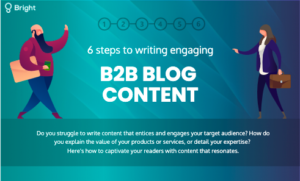How to effectively articulate complex tech and consulting solutions
You’re a smart B2B marketer, business leader or industry expert — but do you struggle to write content that entices and engages your target audience, demonstrates the value of your products or services and showcases your expertise? For anyone who wants to become more visible as a thought leader, we’ve gathered writing tips and guidance on how to write engaging B2B blog content that captivates and resonates with your readers.
Step 1: Build a strong foundation for your content piece
Before you begin writing, create an organised outline to ensure your argument is clear, concise and impactful. Use the following questions to help you lay out the subject, purpose, format and more:
- Main subject: Are you discussing a trend or event, or highlighting a challenge or problem that needs a solution?
- Audience: Who is this for? What information do they already have? What do they need to know?
- Relevance: How does your content relate to their work, business, goals or interests? Why should they care? How will it benefit them?
- Story: Is there a story to tell? What happened to who? Where? When? Why? How?
- Format: Does the subject require classic blog prose or would a list, interview or step-by-step guide format work better?
- Research: What do you need to learn to write this piece? Can you find any stats on the subject? What can you add to existing research?
- Impact: What action should the reader take after reading? How will this benefit your business?
Step 2: Present the value right away
Next, pull out the value of your content. What is the key information you want your readers to take away from your writing? What is your purpose — to guide, educate or inform? Once you’ve pinpointed why anyone should read your piece, be sure to state the value right in your title to grab attention.
- Studies show that popular content titles use ‘How to’, and ‘3/5/10 ways to’, ‘why…’. These titles are eye-catching and assure the reader of a quick, easy and informative reading
- Title format that works: Numbers + verb/adjective + target keyword + rationale + promise
Examples:
- 3 reasons why you’re not a high-performing organisation
- How to hire the best talent and keep them happy and productive
Step 3: Choose a conversational tone of voice
Before you begin, find your tone of voice. Despite what your brand guidelines might say, it’s best to write B2B blog content in a friendly, personal way as if you were having a natural conversation with your reader — remember that you’re writing for the web! It’s also important to remember that you can write with a serious tone without sounding too formal or academic. The last thing you want to do is bore or scare your reader away. Keep the following in mind as you write:
- Talk to the reader directly using ‘you’ and ‘your’
- Avoid sounding robotic by using with contractions: You’re, we’re, isn’t, aren’t, can’t
- Explain tricky technical jargon and acronyms whenever possible
- Stick with the active voice to keep your writing clear and energised
Step 4: Clearly demonstrate your expertise
No matter your subject, you want to show your readers that you know your stuff and that you understand the challenges they’re facing in their business. As you write, keep the following in mind.
- Always try to strengthen your statements with an interesting fact or proven stat
- Use tech or inside-industry phrases and expressions where relevant (but not too many!)
- Reference or link to your case studies, credentials and client advocates
- Turn lengthy or complicated paragraphs into bulleted lists and give instructions in a step-by-step numbered list to avoid overwhelming the reader with information
Step 5: Organise your content for easy reading
In our digital age, people love to scan and read quickly. Make sure you lay out your content piece in a way that puts key information first and explains your point clearly and efficiently. Here’s how to do just that:
Introduction (100-150 words approx.)
Set the scene for your B2B blog content:
- Present the issue, problem or lesson to be learnt
- Tease how you’ll discuss it or lay out the solution
- Explain why it’s important for the reader to learn about this topic — what is the benefit?
Main body (400-600 words approx.)
Lay out the main points to the topic you set up in the introduction:
- Present each point with sub-headers that summarise your argument — this is vitally important for keeping those fast readers engaged
- Loop back to the introduction in each section, giving context or background information
- Remember that each point should contain a “PEE” – Point, Evidence and Explanation. Explain how your offering or solution will help the reader understand recent trends, reach their goals or solve their problem
Conclusion (100 words approx.)
Wrap up your argument with a brief statement that summarises your argument, then end with a strong call to action to prompt your readers to engage further with your brand:
- Keep your summary to one line — short and sweet
- Highlight the value again by reiterating the benefit to your reader
- Hyperlink your call-to-action (CTA) to take the reader to your homepage or solutions
Step 6: Tell them what to do next
Now that you’ve taken the time to share knowledge, be explicit about the next step you want them to make to find out more about your brand. Motivate them with an energising call to action:
- Keep it short, about 5-10 words
- Start with an action verb, such as ‘get’, ‘find out’, ‘see’ ‘learn’, etc.
- Be creative and avoid using the dull and old-fashioned ‘click here’ or ‘here’
- Give a sense of urgency by using ‘today’ or ‘now’
- Make sure it’s relevant to your blog topic and doesn’t feel out of place
Example: Want to learn more about XXXX? Book a meeting today.
Becoming a B2B thought leader in your space demands engaging, strong content — but knowing what to write about and how to sell your point isn’t always easy. If you follow these six easy steps, you’ll create B2B blog content that grabs attention, encourages conversation and tells your readers that you’re someone they can turn to for advice and guidance. For more content tips and tricks, see our insights into writing content for your website, blog and social media pages.
If you prefer to leave it to the experts, our content team at Bright are here to help you reach your business goals through blog writing. Get in touch today at hello@brightinnovation.co.uk


